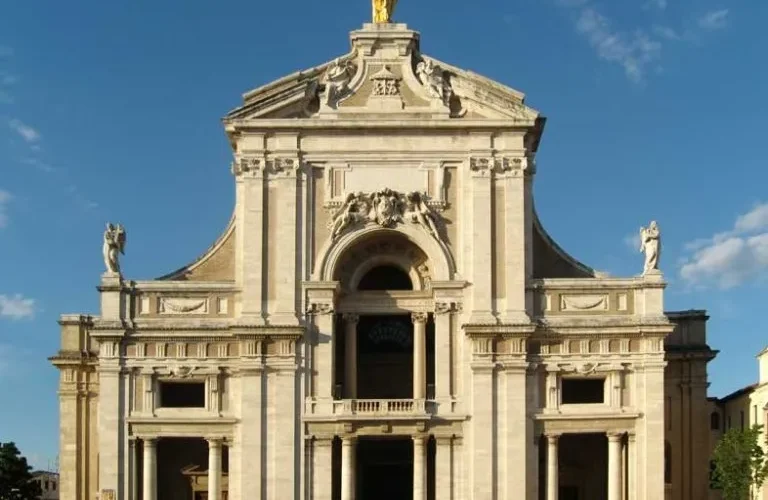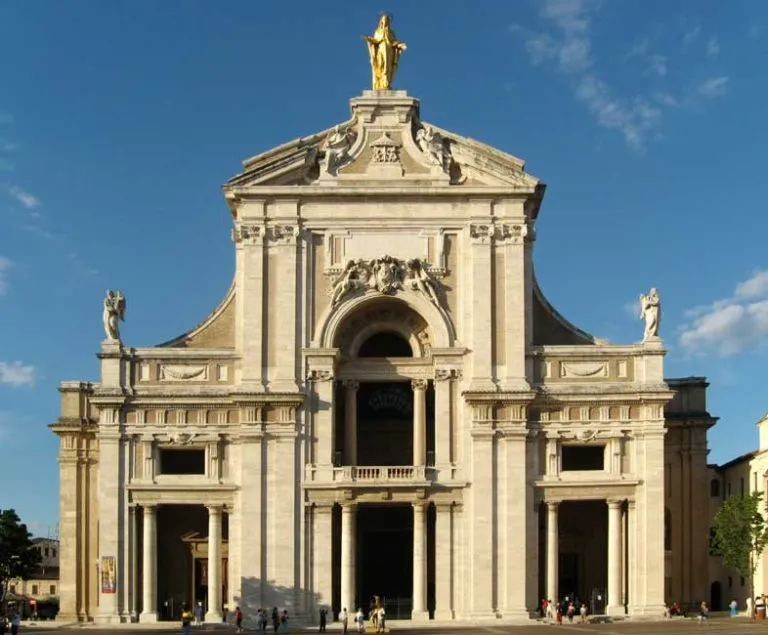
Introduction
The Basilica of Saint Mary of the Angels (Italian: Basilica di Santa Maria degli Angeli) is a Papal minor basilica situated in the plain at the foot of the hill of Assisi, Italy, in the frazione of Santa Maria degli Angeli.
The basilica was constructed in the Mannerist style between 1569 and 1679, enclosing the 9th-century little church, the Porziuncola, the most sacred place for the Franciscans. It was here that the young Francis of Assisi understood his vocation and renounced the world in order to live in poverty among the poor, and thus started the Franciscan movement.
August 2nd is a special day to all Franciscans as it recalls the small Assisi-area chapel that became the foundational home of the Franciscan family – the Porciúncula. It is a place rich in the memory of all Franciscans, and its legacy reaches far and wide. Even as far as California!
The City of Angels
Everyone knows the “City of Angels,” or Los Angeles, CA. But did you know that the name is only the shortened form of the original city name, which grew up around one of the Franciscan missions? The original name of the pioneer town was “El Pueblo de Nuestra Señora la Reina de los Ángeles de Porciúncula” (in English, “City of Our Lady the Queen of Angels of the little Portion”). The Franciscan mission would have lent the Porciúncula to the name, but what is the origin of the remainder of the original name? For that we return to the 13th century and the life of St. Francis of Assisi.
Queen of the Angels
In 1206, when Francis was struggling to determine what it was he was to do with his life, he prayed in the little church of San Damiano just outside the walls of Assisi. There he heard the Word of God saying to him, “Francis, rebuild my church which you see is falling into ruin.” Taking that command very literally, Francis set about rebuilding the little church – stone by stone. He did the same with other abandoned churches in the area. One of them was an abandoned Benedictine chapel in the valley outside Assisi called the porciúncula or “little portion,” referring to the small plot of land associated with the chapel.
In 1209, after returning from a visit to Pope Innocent III, during which Francis received permission to form a “religious order,” Francis and the first brothers took up residence at the porciúncula. The formal name of the chapel was “Our Lady Queen of the Angels.” Now you can see the connection for the Franciscans to name their Californian mission “El Pueblo de Nuestra Señora la Reina de los Ángeles de Porciúncula.” Eventually, the mission became a city and the name was truncated to “Los Angeles.”
History of Saint Mary of the Angels, Porziuncola (Assisi)
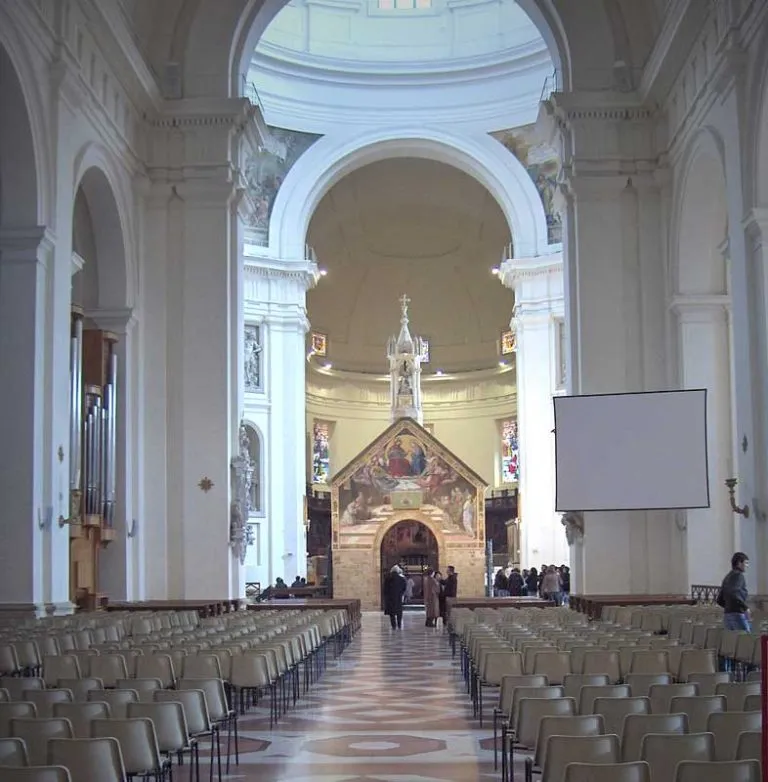
After the death of Saint Francis in 1226, the friars built several small huts around the Porziuncola. In 1230, a refectory and some adjacent buildings were added. In the course of time, little porticoes and accommodations for the friars were added around the Porziuncola. Some foundations of these were discovered during excavations under the floor of the present basilica between 1967 and 1969.
As vast numbers of pilgrims came flocking to Assisi to receive the “Pardon of Assisi”, the small space of the Porziuncola became completely inadequate to house all these pilgrims. The necessity grew to build a church incorporating the Porziuncola. The buildings around the shrine were taken down by order of Pope Pius V (1566–1572), except the Chapel of the Transito, the cell in which St. Francis had died. Construction of the basilica started on 25 March 1569.
This majestic church, the seventh-largest Christian church, was designed in a bold Mannerist style, which prefigured the Baroque style, by two famous architects, Galeazzo Alessi and Vignola. The work progressed slowly, due to a constant lack of money, as the building was financed with donations. The noteworthy dome, resting on an octagonal drum with eight windows and cornices, was finished in 1667. The construction of the church was finally completed in 1679. In 1684 a bell tower was added. It was originally intended to have a twin tower, but the second was never built.
On 15 March 1832 the central nave, a part of a lateral aisle, and the choir collapsed during a violent earthquake. The dome escaped destruction but was left with a wide crack. The apse and the side chapels were left standing. Reconstruction of the basilica started in 1836 by the architect Luigi Poletti and it was finished and reopened for worship in 1840. He remodeled the façade in a neoclassical style.
Between 1924 and 1930 this façade was given back its original pre-Baroque style by Cesare Bazzani. The gold-plated statue of the Madonna Degli Angeli (“Madonna of the Angels”) by the sculptor Colasanti and cast by Ferdinando Marinelli Artistic Foundry, was put on top of the façade in 1930.
On 11 April 1909, the church was raised by Pope Pius X to the status of “patriarchal basilica and papal chapel”.
Architecture of Saint Mary of the Angels
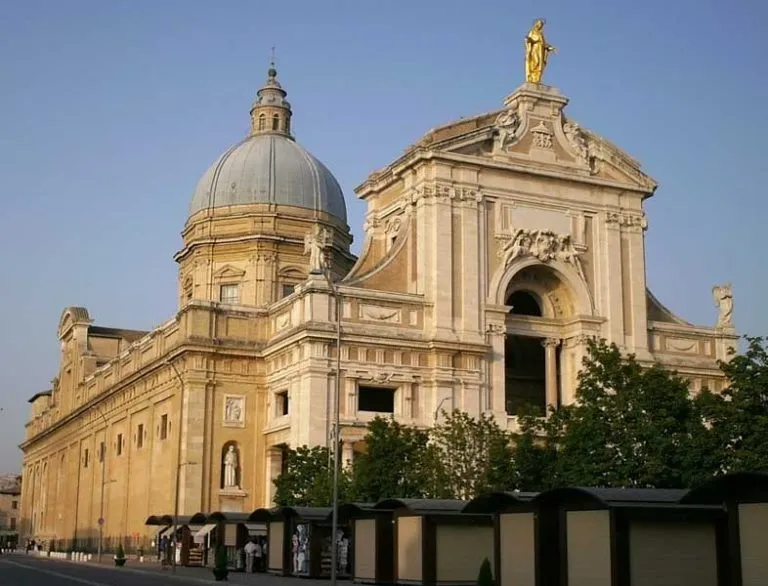
- Architects : Galeazzo Alessi, Giacomo Barozzi da Vignola, Luigi Poletti
- Architectural Styles : Baroque Architecture, Mannerist Style
The Basilica has a rectangular ground plan, divided into a central nave and two lateral aisles, flanked by ten side chapels, with at the far end a transept, and a long choir in a semi-circular apse, protruding from the ground plan. The Porziuncola is situated directly under the dome.
The interior is simple and yet elegant, with only a few decorations, in stark contrast with the decorations of the side chapels. The nave and the aisles were rebuilt in neoclassical Doric style by Luigi Poletti. The apse holds the precious wooden choir, carved by Franciscan brothers starting in 1689, the papal cathedral (with bas-reliefs by E. Manfrini) and the papal altar. The Chapel of the Transito, the cell in which St. Francis died, is still preserved. It is situated under the bay of the choir, against the right columns of the dome.
Saint Mary of the Angels Porziuncola (Assisi) – The side chapels were decorated by great artists from several periods, including Antonio Circignani (all paintings in the Chapel of St Anne, 1602–1603), Francesco Appiani, (Chapels of St. Anthony and St. Peter in Chains, 1756–1760), and Ventura Salimbeni (Chapel of the Removal of the Lord, 1602).
Our Lady, Queen of Angels
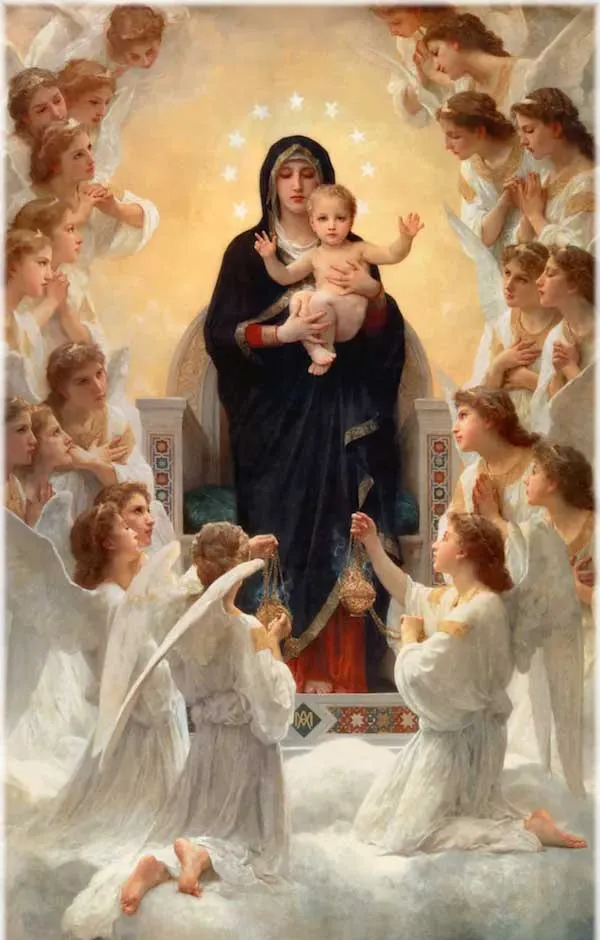
In Franciscan annuals August 2nd is one of the most important days of the year, for it is the Feast of St. Mary of the Angels, the anniversary of the dedication of the birthplace of the Franciscan Order, the day of a special Indulgence, the Portiuncula Indulgence. We have extracted from the author’s article the portion relating the story of St. Francis of Assisi and Our Lady, Queen of Angels.
Saint Mary of the Angels Porziuncola (Assisi) – No subject was more popular at that time than that of Our Lady’s death, Assumption, and Coronation. At Notre Dame Cathedral in Paris three large carvings are dedicated to the Coronation of Our Lady in Heaven, while no less than five great sculptured groups commemorate her death and Assumption. In an exquisitely beautiful stone sculpture at the Cathedral, the Virgin is assumed into Heaven, standing with folded hands inside a fluted shell or aureole of glory, which is itself borne upward by a multitude of Angels.
When the Mother of God is seated at last on her throne beside her Divine Son, most artists envisioned an Angel placing the crown upon her brow while Christ raises His Hand in blessing.
The original pattern, both artistically and devotionally, for the title “Queen of Angels” combined elements from the traditional version of the Assumption, with the impressive imagery used by St. John the Evangelist in his deeply mystical Apocalypse. In it he describes “a woman clothed with the sun, the head a crown of twelve stars.” Still later, St. Michael and his Angels do battle with the seven-headed dragon seeking to destroy the woman and devour her son. “And the dragon and his Angels battled and they prevailed not, nor was their place found any more in Heaven.”
From this description of “The Woman,” artists and writers of the Church drew inspiration. When the Franciscan Order became the special defender of the doctrine of Mary’s Immaculate Conception, this image of the woman clothed in the sun, with the moon beneath her feet, became the symbol and banner of their crusade. There is a remote possibility that the inclusion of these symbols came directly from St. Francis himself.
Shortly after Francis had given up his worldly life and began to live for God, he came upon the ruined chapel in the district around Assisi which had been given the name Santa Maria degli Angelis, or “Our Lady of the Angels.” Entering the little tumble-down church, which was almost hidden under a tangle of flowering vines, the Saint beheld what he thought, in the golden half-light of late afternoon, must be a vision of the Queen of Heaven.
It proved to be an old, old fresco which some long-dead artist had painted on the wall above the main altar. The subject is thought to be the Virgin being assumed into Heaven, accompanied by a court of Angels. This picture would coincide with the name of the chapel. Long before the time of St. Francis the Benedictines had established a monastery near Assisi. It is possible that this chapel was in existence before the Benedictines came. On the other hand, it may have been built by them.
Nevertheless, the Benedictines also owned a small plot of ground to support them which was called “the little portion” or, in Italian, Portiuncula. There for several hundred years the Benedictines remained, and probably the fresco of the Assumption on the wall of the tiny chapel was the work of one of these dedicated and talented monks.
Finally, conditions in this isolated forest spot became so unsettled it was dangerous for the monks to remain; so they moved away and sought the safety of the fortified Benedictine monastery on the nearby slopes of Mount Subasio. When St. Francis came upon the chapel, it was but a charming ruin amidst underbush.
As in the church of San Damiano, where the Lord chose to speak to Francis through an ancient Crucifix so God and His Mother made the little chapel of Our Lady of the Angels a place of inspiration and visions for the poor man of Assisi. On his first recorded visit there, a stranger is said to have come upon him wandering through the chapel, sighing and weeping. Touched by his apparent grief, the man asked what caused him to sorrow.
Francis replied, “I am weeping over the sufferings of my Lord Jesus Christ, and I will not be ashamed to wander around the whole world to weep over them.” The passerby was so overcome by this answer that he burst into tears and wept with Francis! The origin of the Portiuncula Indulgence has been lost in the haze of centuries just as the origin of the chapel itself. The first written document we have regarding this Indulgence is dated October 31, 1277, some sixty years after the Indulgence is said to have been granted.
As a result, many different accounts have come down to us purporting to relate the vision of St. Francis and the way in which the Pope consented to grant this Indulgence. Each author seems to relate a different version that St. Francis beheld. However, although the accounts differ in details, in substance they are the same. The one we present here is the one accepted by Joergensen in his Life of St. Francis.
One time when Francis was kneeling in prayer before the image of Our Lady, he seemed to behold men and women from every corner of the world converging upon this obscure little chapel in the Umbrian forest. He had been praying for the forgiveness of the sins of mankind when suddenly the dark interior seemed illumined by the light of a million candles.
Jesus and Mary appeared in the midst of a dazzling cloud of Angels, and he heard a voice that fell like music on his soul, “What do you wish me to do to help poor sinners?” Francis hardly knew how to answer, but suddenly the words carne tumbling out and he asked the Lord to grant a full pardon to all who came to visit the church of Portiuncula and made a good confession. It then seemed that Jesus was in favor of this. He turned smilingly to His Mother and she, in turn, nodded to St. Francis and smiled.
Typical of the Saint’s impetuosity and generosity of soul, he marched off to see the Pope and beg from him the coveted Indulgence. The reigning Holy Father, Honorius III, was literally dumbfounded at the request to grant such a generous Indulgence. At that time, the summer of 1216, plenary Indulgences were rarely granted by the Church. The plenary Indulgences that had been granted were given to those fighting men who took up the cross and the sword and went as crusaders to the Holy Land. Later, this hard won Indulgence was extended to those who remained at home but helped the Crusaders in supplying men and alms.
Francis, however, was not to be refused. The Lord Himself had promised Him, and the Roman Curia was bound to relent! The Pope finally yielded and left it to the astonished cardinals to limit the application of the new Indulgence. The date set was from vespers of the first of August until sundown on the second. It is said that Francis chose this date because the Feast of the Chains of St. Peter (his release from prison) is celebrated on the first of August, and Francis felt that sinners should also be freed from the chains of their sins on the day following this great Feast. Furthermore, this date was the anniversary of the consecration of the Portiuncula chapel.
As Francis took his leave of the Holy Father, after obtaining the unprecedented privilege, the Pope is said to have asked if he did not wish some document to prove that his request had been officially granted. With characteristic Franciscan light-heartedness came the Saint’s reply: “I need nothing more than your word. Our Lady is the parchment, Christ the notary, and the Angels our witnesses!”
When the first great August first arrived, seven bishops gathered in the little chapel of Our Lady of the Angels to dedicate it as “Our Lady of the Angels of the Portiuncula.” And St. Francis, overjoyed, cried out to the crowd that overflowed the narrow building, “I want to make all of you go to Heaven!”
But at the time there seemed something almost scandalous in this Indulgence, and conservative prelates did little to make it known. In St. Francis’ own lifetime the Portiuncula Indulgence was enjoyed by comparatively few Christians. Travel and communications were slow, and not even such good news as a plenary Indulgence could travel swiftly over the mud-choked trails that passed for roads in thirteenth-century Europe. Later, of course, the Indulgence was extended to all Franciscan churches on August first and second.
The Basilica of Saint Mary of the Angels, Porziuncola (Assisi) was the Saint’s favorite spot on earth. It was here he heard the Gospel that caused him to establish his First Order, following the command of Christ to go into the world and preach and Baptize all men, taking neither gold nor script nor an extra cloak for the journey. Here Francis received his first brothers, and from here he sent them into the world.
In this chapel, St. Clare knelt before the image of Our Lady of the Angels, and on the floor her golden tresses fell beneath the scissors plied by Francis himself. Indeed, Francis placed such a high value on this chapel, which he had rebuilt with his own hands, that he wrote a special rule just for “Portiuncula.”
It was scarcely two centuries and a half later that an Italian Third Order member, recently named the Admiral of the Ocean Seas by the King and Queen of Spain, spent the entire night of August second, 1492, in prayer in a chapel dedicated to Our Lady in the port town of Palos on the coast of Spain.
On the morning of the third, he and his cockleshell fleet of three caravels sailed down the golden tide of the Rio Tinto, past the Franciscan monastery of Our Lady of the Angels of La Rabida. Here good friends were chanting the hour of prime—–friars who had gone to court for the Admiral, Christopher Columbus, had cared for his son, Diego, and who would now be praying to Our Lady of the Angels to watch over the precarious enterprise which was launched on such a great Franciscan Feast day.
Every man aboard the fleet had confessed his sins and received Holy Communion, and thanks to the plenary Indulgence obtained by St. Francis (now extended to all Franciscan churches as well as the chapel of the Portiuncula), some of those men who would not return from that perilous voyage were able at last to make the port of Heaven.
The sons of Francis followed quickly in the wake of the Santa Maria, the Pinta, and the Nina, and soon hundreds of grey, brown, and blue-robed friars were working in the newly discovered regions. With them went the ancient devotion to Our Lady of the Angels. Mexico abounded with chapels dedicated to her. In our own state of New Mexico, a mission outpost in the Indian village of Pecos, not far from Santa Fe, was given her name as early as 1617.
In 1769, the Spanish expedition to Upper California, under the command of Gaspar de Portola, arrived at a great plain, well watered by a fine river, on the second of August of that year. For this reason the river was given the name of the Rio Porciuncula (the Spanish spelling). Later, on September 4, 1781, when some forty-eight soldiers and settlers founded a town on this one-time camping site, they gave it the name El Puebla de Nuestra Senora, la Reina de los Angeles del Rio de Porciuncula, (The Town of Our Lady, Queen of Angels of the River of Portiuncula).
There was little to recommend the poverty-stricken village in those days, and it could hardly live up to such an impressively long title. Gradually it was shortened to the simpler “Los Angeles,” and still later in our own time-conscious age to the initials, “L.A.”
Saint Mary of the Angels Porziuncola (Assisi) – But the church in the old plaza, facing the Union Station, is a worthy successor to the original chapel of Our Lady of the Angels. The Blessed Sacrament is exposed twenty-four hours a day. Worshipers of many nationalities crowd the chapel for ’round-the-clock adoration of their Lord. The real patroness of this great city of six million souls is still she who has Angels wherever she goes, the woman clothed in the sun, with the moon beneath her feet.
No one has ever better described the full significance of this devotion to Mary than St. Francis himself when he said to Pope Honorius: “I need nothing more than your word. Our Lady is the parchment, Christ the notary, and the Angels our witnesses!”
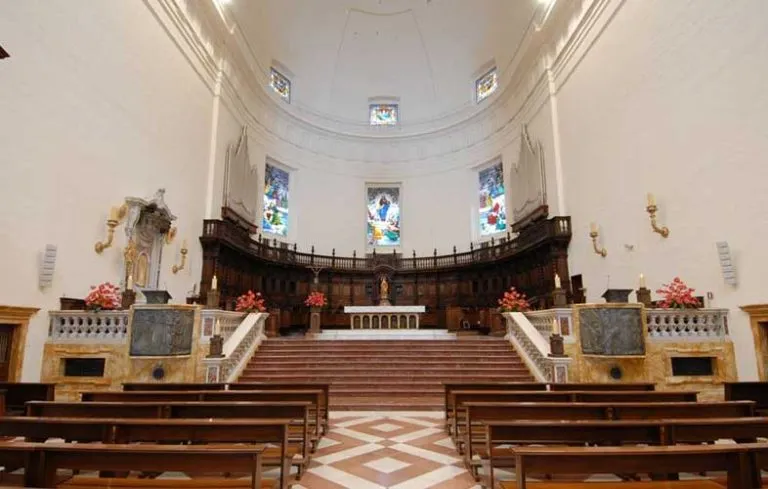
The Virgin with Angels
The Virgin with Angels is a 1900 painting by William-Adolphe Bouguereau. The painting media is oil on canvas, and it measures 185 × 285 cm (72.8 × 112.2 in).
It is currently located in Petit Palais, Paris. The Virgin with Angels is one of William’s most iconic paintings, and it involves highly complex work that has many figures that helped to inspire this painting.
The painting depicts Virgin Mary the mother of Jesus holding her baby while seated on the throne seat with angels admiring and praising the baby. The artist used both bright and cool colors in the painting to give it more meaning.
The focus on details that William gave to each angel and the charming manner the painting was put together giving the main attention to the virgin and her child at the center of the painting, gave the painting a great longevity.
The painting depicts some of the angels standing while other kneeling wearing white gowns decorated with golden colors and burning expensive incense to praise the Virgin and her child.
The use of white gowns worn by the Angels depicts the holiness and purity of the angel. On the other hand, the Virgin was painted wearing a black gown with golden decorations depicting she was at a lower lever compared to the angels.
Bouguereau painted the baby naked to show that he was really in human being form even though he was the son of the god. The baby was painted with his hands raised and right hand displaying a sign of peace. This was clearly thought and put together painting as it speaks directly to the viewer.
The Virgin was painted sitting on the throne seat that is golden decorated to depict her blessings and authority among the humanity. The painting could not have been complete without the crown of the stars around the virgin head to depict her authority was from above.
The burning of incense by the angels using golden vessels in the painting depicted that the child was really a king who commanded authority among the angels and human beings.
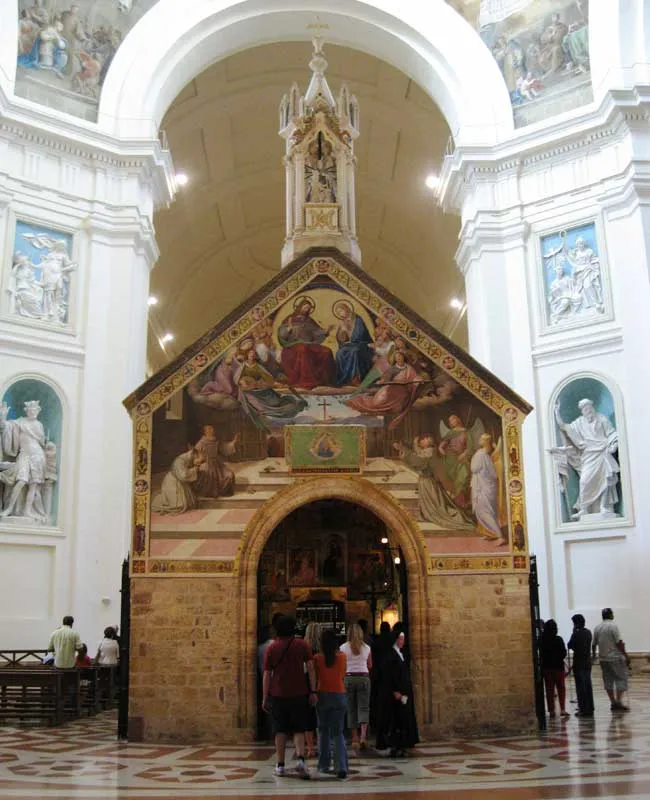
The Porziuncola
The small church dedicated to Santa Maria degli Angeli, probably built in the 4th century and subsequently passed under the ownership of the Benedictine monks, takes its name from the area called “Portiuncula”, which literally indicates the small portion of land on which it stood.
Remained for a long time in a state of neglect, it was the third church to be restored directly by St. Francis after the “mandate” received from the Crucifix of San Damiano.
Here he clearly understands his vocation and here he founded the Order of Friars Minor in 1209, entrusting it to the protection of the Virgin Mother of Christ, to whom the church is dedicated.
From the Benedictines Francesco obtained the place and the chapel as a gift to make it the center of the new nascent Order.
On 28 March 1211, Chiara di Favarone di Offreduccio receives the religious habit from the Saint, starting the Order of Poor Ladies (Poor Clares).
In 1216, in a vision, Francis obtained from Jesus himself the Indulgence known as the “Indulgence of the Porziuncola” or “Pardon of Assisi”, approved by Pope Honorius III.
At the Porziuncola, which was and is the center of Franciscanism, the Poverello gathers his friars every year in the Chapters (general meetings), to discuss the Rule, to rediscover fervor again and to start again to proclaim the Gospel to the whole world.
The Church is decorated by artists from different periods. Above the entrance is the fresco by Johann Friedrich Overbeck (1829) depicting St. Francis receiving from the Christ and the Virgin the indulgence, known as the “Pardon of Assisi”. The side wall on the right side shows fragments of two frescoes by an unknown Umbrian artist. The austere interior is decorated in a simple Gothic style with frescoes from the 14th and the 15th century.
The most outstanding work is the six-part fresco in the apse of this little church, painted by Ilario da Viterbo (1393). At the back, above the entrance, is a fresco depicting the Crucifixion by Pietro Perugino.
Table of Priest Hilary
Entering Porziuncola, one is immediately flooded by the light and colors of the altarpiece by Prete Ilario da Viterbo (1393).
In the succession of the five paintings the story of the Pardon of Assisi is told.
Francis throws himself among the thorns to overcome temptation; accompanied by two angels he goes to Porziuncola; in it he contemplates the apparition of Jesus and the Virgin and asks for the plenary indulgence; he asks the Pope for confirmation; and finally announces to everyone the great gift received from Christ and the Church.
Interior of the Porziuncola
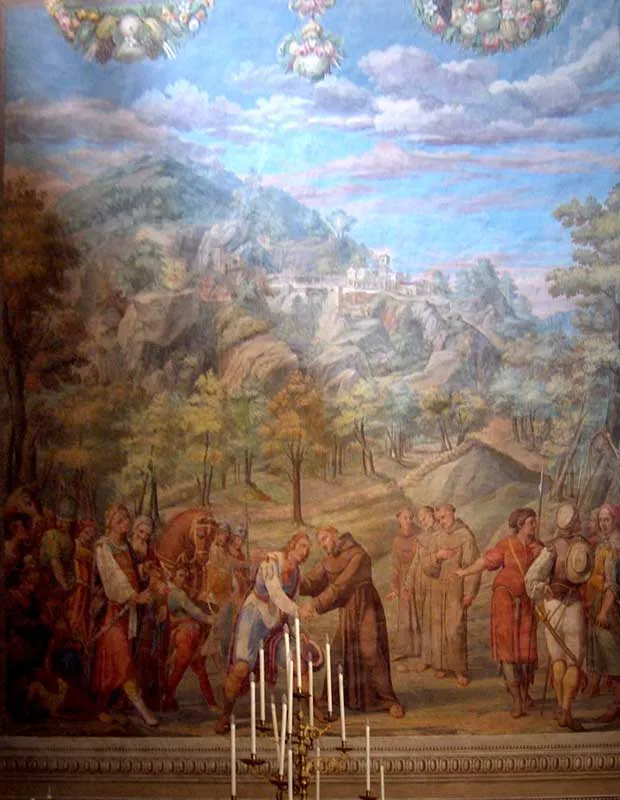
It retains all the freshness of the primitive Franciscan austerity.
The roughly squared stones recall the inexperienced hand of the young restorer Francesco. But in their reflections there is the echo of the incessant prayer that for centuries has risen towards the sky from this “small portion” of earth.
Millions of souls have passed through this “door of eternal life” and prostrated themselves here to find peace and forgiveness in the great Indulgence.
On the threshold of the church the words “hic locus sanctus est” are engraved, this place is holy, because God came down to meet Francis and anyone who enters it with faith.
The Transito
The Cappella del Transito is the small room where St. Francis died on 3 October 1226. It was a little hut serving as a primitive infirmary for the sick. It is decorated at the outside by the fresco of The transito by Domenico Bruschi (1886). On the inside, above the small altar, is the rope of St. Francis. Behind the altar, there is a glazed terracotta statue of St. Francis by Andrea della Robbia (1490). On the walls there is a fresco by Giovanni Spagna (1520), depicting the earliest followers of St. Francis, with their names above each portrait (Ruffino, Leone, Masseo and Egidio).
The Crypt
A new crypt was constructed behind the altar between 1965 and 1970. During the excavations, foundations of the original little huts, surrounding the Porziuncola, were exposed. The crypt’s altar rests on a massive, multiple-branched tree trunk, sculpted by Francesco Prosperi.
Behind the altar stands an enameled, terracotta, bas-relief tabernacle by Andrea della Robbia, expressing with an extreme finesse the emotions of the figures. The upper portion section includes St Francis receiving the Stigmata, the Coronation of Mary (with the angel musicians), and St Jerome the Penitent; the lower has the Annunciation, the Nativity, and the Adoration by the Magi.
The Rose Garden and the Rose Chapel
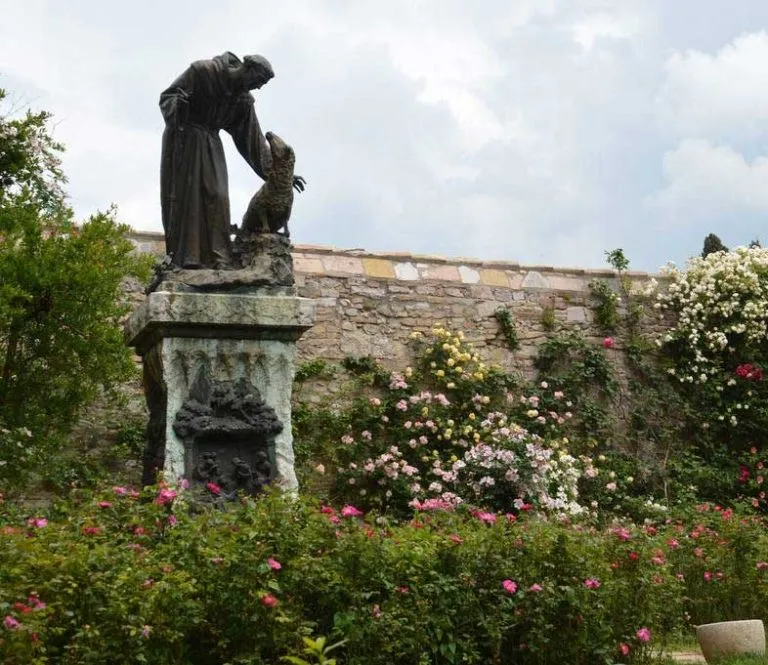
One enters the rose garden via the sacristy. It is the last remains of the ancient wood in which St Francis and his friars lived. Here he talked to the turtle doves, inviting them to praise the Lord. Doves have been nesting since times immemorial in the hands of the statue of St. Francis in this rose garden.
According to tradition (already attested at the end of the 13th century), one night St. Francis, feeling the temptation to abandon his way of life, rolled naked in the bramble thorns in an attempt to overcome doubt and temptation. In contact with his body, the bramble bushes turned into dog roses without thorns. Since then, the dog rose cultivar Rosa canina assisiensis has been grown in the garden.
From the rose garden, one enters the Rose Chapel. This was the cell where St. Francis rested and spent the rest of the night in prayer and penance. Here St. Francis also met Saint Anthony of Padua. After his death a chapel was built in the 13th century and enlarged in the 15th century by St. Bernardine of Siena. It was decorated between 1506 and 1516 with a series of frescoes by several painters, including Umbrian Tiberio d’Assisi who depicts the early Franciscan community and the first saints of the order, the miracle of the roses, and the concession of the indulgence.
Museum
The little friary houses the museum of the Porziuncola with many religious objects, archaeological finds, and a noteworthy collection of paintings:
- The Crucifix by Giunta Pisano (1236)
- A wooden painting portrait of St. Francis by the (anonymous) Maestro di San Francesco (13th century); the body of the deceased saint was placed on this painting
- A painting on wood of St. Francis attributed to Cimabue
- A Madonna with Child by the Sienese painter Sano di Pietro (15th century)
- A terracotta by Andrea della Robbia (1490) with in the top from left to right : “St. Francis receives the Stigmata”, “Coronation of Mary” and “St. Jerome the penitent”; bottom, from left to right : “the Annunciation”, “the Nativity”, and “the Adoration of the Magi”.
- St. Francis and St. Clare by Cesare Sermei and his workshop
- the Madonna of the Milk, a polychromed terracotta sculpture (end of the 14th or early 15th century)
- many frescoes of uncertain attribution.
Feast Day – 2nd August
The Feast of Our Lady, Queen of Angels, August 2, 1492.
The Feast of Our Lady of the Angels of the Porziuncola : August 2nd, the anniversary of the dedication of the birthplace of the Franciscan Order, the day of a special Indulgence, the Portiuncula Indulgence.
Mass Time
Weekdays
Sundays
Church Visiting Time
Contact Info
Basilica of Saint Mary of the Angels,
1, Piazza Porziuncola,
06081 Santa Maria degli Angeli PG, Italy
Phone No.
Tel : +39 075 805 1430
Accommodations
How to reach the Basilica
Perugia San Francesco d’Assisi – Umbria International Airport in Umbria, Italy is the nearby airport to the Basilica.
Assisi Railway Station in Assisi, Umbria, Italy is the nearby train station to the Basilica.

